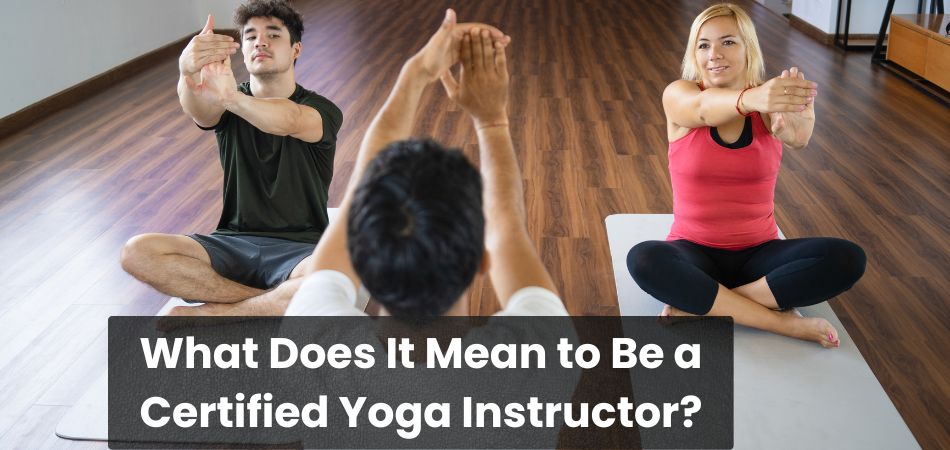Yoga has become a global phenomenon, offering physical, mental, and spiritual benefits to practitioners. For many, this passion evolves into a calling to teach and share its transformative power with others.
Becoming a certified yoga instructor not only allows you to deepen your practice but also equips you with the skills to guide others on their journey. So, how to become certified yoga instructor?
To become a certified yoga instructor, complete a 200-hour training program, register with a recognized organization, and gain hands-on teaching experience. Stay committed to lifelong learning and professional growth.
With this guide, we’ll walk you through the steps, from selecting a registered yoga school to acing the certification process, ensuring you’re well-equipped to teach with confidence and authenticity. Let’s take a look at your path to becoming a yoga professional.
What Does It Mean to Be a Certified Yoga Instructor?
Being a certified yoga instructor means more than just knowing how to perform poses; it’s about embodying the principles of yoga and guiding others on their journey toward physical and mental well-being. Certification signifies that an individual has undergone comprehensive training in yoga philosophy, anatomy, teaching methodologies, and safe practice techniques.

It establishes a standard of professionalism and ensures that the instructor has the knowledge and skills to teach effectively and safely. A certified yoga instructor understands the diverse needs of students and arranges their classes to accommodate various skill levels and physical abilities.
They are also adept at creating a nurturing and inclusive environment, advancing growth and mindfulness. This role goes beyond the physical; it involves inspiring others to connect with their inner selves and lead more balanced lives.
Certification also reflects a commitment to continued learning and growth. Instructors often pursue ongoing education to deepen their practice, explore new styles, and stay updated with industry standards.
Benefits of Becoming a Certified Yoga Instructor
Becoming a certified yoga instructor opens up a world of personal growth, professional opportunities, and community impact. It allows you to deepen your own yoga practice while empowering others to lead healthier, more mindful lives. Below are some key benefits of earning your yoga instructor certification.
Deepen Your Personal Yoga Practice
Certification training immerses you in the principles and techniques of yoga, allowing you to refine your practice. You gain a deeper understanding of poses, breathing techniques, and meditation. This personal growth strengthens your connection with yoga on a physical, mental, and spiritual level.
Build a Rewarding Career
Certified instructors can teach in studios, fitness centers, or even run their own classes. The growing popularity of yoga means there is increasing demand for skilled teachers. You can also explore niche markets, like corporate yoga or therapeutic yoga, expanding your professional options.
Help Others Achieve Wellness
As a certified yoga instructor, you have the power to guide others toward physical fitness and mental clarity. Your teachings can improve your students’ flexibility, strength, and stress management. Helping others find balance and peace through yoga is deeply fulfilling.
Join a Global Yoga Community
Earning your certification connects you with a network of like-minded practitioners and instructors. This community offers opportunities for collaboration, learning, and growth. Being part of this supportive environment inspires you to continuously evolve in your yoga journey.
Develop Transferable Skills
Teaching yoga equips you with skills like communication, leadership, and empathy. These abilities can be applied beyond yoga, bettering your personal and professional relationships. Additionally, managing classes and creating lesson plans strengthens organizational and time-management skills.
How to Become Certified Yoga Instructor?
Becoming a certified yoga instructor is an exciting journey of self-discovery, education, and professional growth. Whether you aim to deepen your personal practice or share yoga with others, the certification process equips you with the knowledge and tools to succeed. Here’s a step-by-step guide to help you navigate the path to becoming a certified yoga instructor.

1. Know Why You Want to Teach Yoga
Before diving in, reflect on your motivation for becoming an instructor. Is it to share yoga’s benefits, start a new career, or deepen your practice? Understanding your goals will guide your choices throughout the process. Clarity in purpose ensures you stay committed and focused.
2. Research Yoga Certification Requirements
Certification requirements vary by region, so research what’s necessary in your area. Most certifications align with Yoga Alliance standards, which require completing a 200-hour training. Additionally, consider the type of yoga you wish to teach, as this can influence the program you choose. Knowing the prerequisites helps you plan effectively.
3. Choose the Right Teacher Training Program
Select a training program that aligns with your goals, schedule, and budget. Look for accredited programs that cover essential topics like anatomy, philosophy, and teaching techniques. Decide whether you prefer in-person training, a retreat format, or online classes. Reading reviews and talking to past students can help you make an informed choice.
4. Complete Your Yoga Teacher Training (YTT)
During your training, you’ll immerse yourself in yoga theory and practice. Expect to learn about poses, breathing techniques, meditation, and teaching methodologies. This is also a time to build your confidence through practice teaching sessions. Completing the course earns you the certification required to start your teaching journey.
5. Register with a Recognized Yoga Organization
After completing your training, register with a reputable organization. Registration strengthens your credibility and signals professionalism to potential employers or students. Many yoga studios and clients prefer instructors who are registered with such organizations. This step also grants you access to valuable resources and a professional network.
6. Gain Teaching Experience
Start by teaching small classes or assisting experienced instructors. This hands-on experience allows you to refine your teaching skills and gain confidence. You’ll learn to manage a class, adjust poses safely, and connect with students. Over time, your style and approach will naturally evolve.
7. Commit to Lifelong Learning
Becoming a yoga instructor is just the beginning; ongoing education is essential for growth. Attend workshops, advanced training, and retreats to deepen your expertise. Explore new yoga styles, techniques, and trends to stay relevant and inspired. Lifelong learning keeps your teaching fresh and meaningful for your students.
How Long Does It Take to Become a Certified Yoga Instructor?
The time it takes to become a certified yoga instructor depends on the type of training program you choose and your personal schedule. A standard 200-hour Yoga Teacher Training (YTT) program, which is the minimum requirement for certification, can be completed in as little as four weeks through an intensive course. Alternatively, many part-time programs spread the training over several months to accommodate those with busy schedules.
Your pace will also depend on your level of commitment and availability. Full-time programs are immersive and allow you to complete your training quickly, often in retreat-style settings. Part-time or weekend courses provide more flexibility, making it easier to balance training with work or family responsibilities, but they require a longer time commitment, typically three to six months.
After completing the required hours, you’ll need additional time for certification registration and gaining teaching experience. Overall, the journey to certification can range from a few weeks to a year, depending on your chosen path and dedication.
Can You Become a Certified Yoga Instructor Online?
Yes, you can become a certified yoga instructor online, thanks to the increasing availability of virtual teacher training programs. Many online courses are accredited by yoga organizations, ensuring they meet industry standards. These programs offer flexibility, allowing you to study and practice at your own pace from the comfort of your home.
Online training typically includes live or recorded video sessions covering yoga philosophy, anatomy, and teaching techniques. While virtual learning requires discipline, many programs incorporate interactive elements like live Q&A sessions, peer collaborations, and practice teaching to ensure comprehensive learning. This format is especially appealing to those with busy schedules or limited access to in-person training.
However, you should choose a reputable program that balances theory with hands-on practice. Some online certifications may require in-person components for practical assessments. With the right program, you can successfully complete your training and begin your journey as a certified yoga instructor.
What Skills Do You Learn in Yoga Teacher Training?
Yoga teacher training is an immersive process that equips you with a wide range of skills to teach and practice yoga effectively. Beyond learning poses and techniques, you’ll also develop valuable communication, leadership, and mindfulness skills. Here are some essential skills you’ll gain from completing yoga teacher training.

Anatomy and Alignment
Teaching yoga safely requires knowledge of the human body. Yoga teacher training provides in-depth knowledge of anatomy, helping you learn how muscles and joints function during various poses. For example, knowing the tree pose internal rotation is essential for ensuring proper alignment in the hips and knees. This knowledge allows you to guide students effectively, ensuring injury prevention and optimal body positioning in poses.
Sequencing and Class Planning
A core skill developed during training is how to create well-rounded yoga sequences. You’ll learn to design classes that flow smoothly, incorporating appropriate warm-ups, peak poses, and cool-downs. Knowing how to plan for different levels of students will make you a more versatile instructor.
Teaching and Communication
Clear and effective communication is essential for a yoga instructor. During training, you’ll learn how to give clear verbal cues, demonstrate poses, and offer adjustments to students. These skills will help you build confidence in teaching and connect with students more effectively.
Mindfulness and Meditation Techniques
Yoga isn’t just about physical postures; it’s also a practice of mental and emotional awareness. Through your training, you’ll learn meditation and mindfulness techniques to incorporate into your classes. These practices help students connect more deeply with themselves, improving the yoga experience.
Adaptability and Problem-Solving
Every student’s body and needs are different, and yoga teacher training teaches you how to adapt your teaching. You’ll gain the skills to offer modifications for beginners or students with injuries. This flexibility ensures that all students feel supported and safe in your classes.
Frequently Asked Questions About Becoming a Certified Yoga Instructor
Starting the journey to becoming a certified yoga instructor can raise many questions. Whether you’re curious about the process, requirements, or the post-certification experience, it’s essential to understand the details. Below are five frequently asked questions to help clarify the path to becoming a certified yoga instructor.
1. How Much Does Yoga Teacher Training Cost?
The cost of yoga teacher training varies depending on the program and location, typically ranging from $2,000 to $5,000. Some programs may offer payment plans or scholarships to make the investment more manageable. While the initial cost can seem high, many instructors find that the career opportunities and personal growth are well worth the investment.
2. Do You Need Prior Yoga Experience to Become a Teacher?
While having a consistent yoga practice is beneficial, most teacher training programs do not require extensive prior experience. However, a basic understanding of yoga principles can help you grasp the training more easily. Many programs welcome beginners and help them build the necessary foundation during the course.
3. Can You Teach Yoga Immediately After Certification?
Yes, once you have completed your certification, you are qualified to start teaching yoga. However, many new instructors gain experience by teaching small classes, offering private sessions, or assisting other teachers. This hands-on practice helps build confidence and refine your teaching skills.
4. Is It Necessary to Become Yoga Alliance Registered?
While it’s not required by law, becoming Yoga Alliance registered is a significant advantage for yoga instructors. Many studios and employers prefer or require certification through Yoga Alliance, as it ensures you meet established professional standards. It also provides you with access to a broader network and resources for ongoing development.
5. Can I Teach Yoga Abroad with a Certification?
Yes, most yoga certifications are internationally recognized, allowing you to teach yoga around the world. However, it’s essential to check the local regulations in the country where you plan to teach, as some places may have additional licensing requirements. The flexibility to teach globally is one of the appealing aspects of becoming a certified yoga instructor.
Final Words
Becoming a certified yoga instructor is an enriching journey that combines personal growth and the opportunity to inspire others. By completing the necessary training and gaining hands-on experience, you will be well-equipped to teach yoga with confidence and expertise.
Whether you’re passionate about deepening your practice or sharing the benefits of yoga with others, knowing how to become certified yoga instructor is the first step toward making a positive impact. With dedication, the right training, and a commitment to lifelong learning, you’ll be ready to start your career as a skilled and inspiring yoga teacher.
